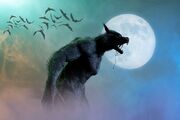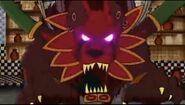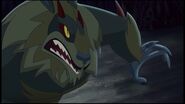
In Mesoamerican folk religion, a nahual (pronounced [na'wal]) is a human being who has the power to shapeshift into a jaguar form. A widespread superstition holds that Naguals must make a pact with the devil as well as make him an offering.
The word nagual derives from the Nahuatl word nahuālli [naˈwaːlːi], an indigenous religious practitioner, identified by the Spanish as a 'magician'.
In English, the word is often translated as "transforming witch", but translations without witch's negative connotations include "transforming trickster" or "shape shifter".
Naguals use their powers for good or evil according to their personality. The general concept of Nagualism is pan-Mesoamerican. Nagualism is linked with pre-Columbian shamanistic practices through Pre-classic Olmec depictions that are interpreted as human beings transforming themselves into animals. The system is linked with the Mesoamerican calendrical system, used for divination rituals. Birth dates often determine if a person can become a nagual. Mesoamerican belief in tonalism, wherein every person has an animal counterpart to which his life force is linked, is drawn upon by Nagualism.
The nagual trait is acquired at birth, along with other characteristics associated with a person's birth day. Each day is associated with an animal that has strong and weak aspects. A person born on "Dog Day" would have both strong and weak 'dog' aspects. In Nahuatl the word tonalli is used to refer both to a day and to the animal associated with that day.
The nagual is considered different; where the tonal is the day spirit itself, the nagual is the spirit familiar of the day. It is probable that the tonal represents the daytime aspect and the nagual the nighttime aspect of the tonalli, 'the things of the day'. Practitioners of powerful magic were normally born on days related to animals with a strong or harmful aspect. They would have specific tonals such as the jaguaror puma. In Aztec mythology the god Tezcatlipoca was the protector of Nagualism, because his tonal was the jaguar and he governed the distribution of wealth.
In modern rural Mexico, nagual is sometimes synonymous with brujo ("wizard"): one who is able to shapeshift into an animal at night, (normally into a dog, owl, bat, a big wolf, or turkey) drink blood from human victims, steal property, cause disease, and the like.
In some indigenous communities the nagual is integrated into the religious hierarchy. The community knows who is a nagual, tolerating, fearing and respecting them. Nagualli are hired to remove curses cast by other nagualli.
In other communities the accusation of Nagualism may result in violent attacks on the accused by the community.
The Western study of Nagualism was initiated by archaeologist, linguist, and ethnologist Daniel Garrison Brinton who published Nagualism: A Study in Native-American Folklore and History, which chronicled historical interpretations of the word and those who practiced Nagualism in Mexico in 1894. He identified various beliefs associated with Nagualism in modern Mexican communities such as the Mixe, the Nahua, the Zapotec and the Mixtec.
Subsequently, many studies have described Nagualism in different Mesoamerican cultures such as the Zoques and the Jakaltek, K'iche', Q'eqchi', and Tzeltal Maya. Among the Jacaltek, naguals reinforce indigenism by punishing those who collaborate with non-indigenous ladinos.
In 1955, Gustavo Correa suggested Nagualism is not pre-Columbian, arguing that it was wholly imported from Europe, where he compared it to the medieval belief in werewolves. However, shapeshifting folklore is not limited to Europe, nor to the Middle Ages; for example, some of Earth's oldest literature, the Bronze Age Eastern Semitic Epic of Gilgamesh, and East Asia's Huli Jing (origin of this folklore is of unknown date, but eighteenth century at the latest), contain shapeshifters. The werewolf (lycanthropy) is neither the only nor the earliest form of folklorical therianthropy (shapeshifting from human to animal, or vice versa).
A solid consensus of authors and curators today interpret pre-Columbian art as expressing a belief in therianthropic shapeshifting, often citing hallucinogenic drugs as the root of the Mesoamerican and Desert Southwest shapeshifter folktales.
Kaplan concludes that, in Oaxaca, the belief in naguals as evil, shape shifting witches is common in both indigenous and Mestizo populations. According to Kaplan, the belief in animal spirit companions is exclusively indigenous. This is certain for some groups and communities, but for others, such as the Mixes, Chinantecos, Triquis, or Tacuates, those who can control their nahual or alterego are protectors of the people, natural resources and culture of the community, highly revered, but also feared.
In 1887, Sergeant Oscar Francisco Gimenez Nava was found to be a nagual. Some villagers said they saw him transform into a wolf. They chased after him but witnesses say he was too fast to overtake and he escaped.
The nagual was popularized in shamanism books by author Carlos Castaneda. He defined the nagual as, "the teacher who becomes the gateway, the doorway, the intermediate between the world of the “seeker” or apprentice, and the world of the spirit."


